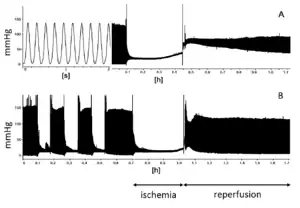Langendorff heart
The Langendorff heart or isolated perfused heart assay is an ex vivo technique used in pharmacological and physiological research using animals and also humans.[1] It allows the examination of cardiac contractile strength and heart rate without the complications of an intact animal or human.[2] After 90 years this method is still being used. [3]

Method
In the Langendorff preparation, the heart is removed from the animal's or human's body, severing the blood vessels; it is then perfused in a reverse fashion (retrograde perfusion) via the aorta, usually with a nutrient rich, oxygenated solution (e.g. Krebs–Henseleit solution or Tyrode's solution). The backwards pressure causes the aortic valve to shut, forcing the solution into the coronary vessels, which normally supply the heart tissue with blood. This feeds nutrients and oxygen to the cardiac muscle, allowing it to continue beating for several hours after its removal from the animal or human. This is a useful preparation because it allows the addition of drugs (via the perfusate) and observation of their effect on the heart without the complications involved with in vivo experimentation, such as neuronal and hormonal effects from living animal or human.[4] This preparation also allows the organ to be digested into individual cells by adding collagenase to the perfusate. This can be done before the experiment as a technique for cell harvesting, or after the experiment to measure its effects at the cellular level.
See also
References
- Tseng, Chung-E (1999). "mRNA and Protein Expression of SSA/Ro and SSB/La in Human Fetal Cardiac Myocytes Cultured Using a Novel Application of the Langendorff Procedure". Pediatric Research. 45 (269): 260–9. doi:10.1203/00006450-199902000-00018. PMID 10022600.
- Bell, R., Mocanu, M. & Yellon, D. Retrograde heart perfusion: The Langendorff technique of isolated heart perfusion. Journal of Molecular and Cellular Cardiology 50, 940-950 (2011).
- Döring, HJ (1990). "The isolated perfused heart according to Langendorff technique--function--application". Physiologia Bohemoslovaca. 39 (6): 481–504. ISSN 0369-9463. PMID 2103635.
- The Langendorff heart preparation—Reappraisal of its role as a research and teaching model for coronary vasoactive drugs, K.J. Broadley, Journal of Pharmacological Methods
